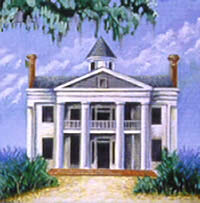
The main house was a stately mansion
with six galleries and towering pillars. Built of brick
covered with stucco, the house had the appearance of
solid stone construction. Painting by John R. Lowery,
courtesy Lake Jackson Historical Association.
Click images to enlarge
|
|
Massive debt and murderous family rancor ravaged
the Jackson business, and the plantation eventually
had to be sold.
|
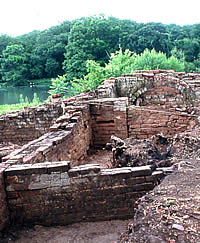
Excavation at the Jackson Plantation
sugar mill is helping archeologists understand changes
in construction and refinery technology over time, as
slave labor was supplanted by convict labor. Photo by
Norman Flaigg.
|
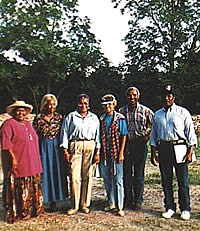
Descendants of John Jackson, oldest
son of Abner and Margaret Jackson, tour the ruins open
house held during the Texas Archeological Society of
field school. Some 300 strong, the "Black Jacksons,"
as they refer to themselves, hold a family reunion each
year in Brazoria County.
|
|
On the lush banks of a tranquil lake on the
upper Texas Gulf coast, the crumbled ruins of brick buildings
are all that remain of a once thriving plantation. The business
of the plantation was making sugar: thousands of pounds of
sugar cane grown in the fields were processed in the plantation's
mill. First African-American slaves, then convicts from nearby
prison farms provided the backbreaking labor to make the industry
profitable in the fertile coastal land known as the "sugar
bowl of Texas."
Built by Abner Jackson and his wife, Margaret,
in 1844, the Lake Jackson Plantation became one of the most
profitable sugar refineries in the state. Over time, Jackson
expanded his namesake property to almost 3750 acres and acquired
two additional plantations, Darrington and Retrieve. But massive
debt and murderous family rancor ravaged the Jackson business,
and Lake Jackson plantation eventually had to be sold. Subsequent
owners struggled with the upheaval in business brought about
by the Civil War, a changing economy and a new labor force.
In 1900, the infamous hurricane that killed over 6,000 people
in Galveston also delivered the final death blow to the plantation,
nearly leveling many of the stately buildings and sugar mill
complex. Although the land continued to be cultivated for
crops and later was used as range land for cattle, the buildings
were never reconstructed.
Nearly a century later, archeologists began
probing the weed-infested ruins, hoping to learn more about
the plantation and the technology of sugar making. Joan Few,
professor at the University of Houston at Clear Lake, has
directed excavations at the site near Freeport, Texas, since
1992. Now a State Archeological Landmark, the property includes
the remains of 12 structures on roughly four acres of land—a
mere shadow of the original plantation.
Through the efforts of hundreds of volunteers
and students, including members of the Texas Archeological
Society (TAS) and the Brazosport and Houston archeological
societies, much of the elaborate brick-walled plantation and
mill complex has been uncovered, allowing researchers to track
changes in construction through time. Significantly, archeologists
learned to recognize the finer craftsmanship of the slave-labor
era, as distinguished from the poorer quality work produced
by convicts.
Today there are no nineteenth-century sugar
mills standing in Texas, but archeological research at Lake
Jackson has provided a wealth of information on the first
industry in Texas, that of refining sugar.
Missing from the archeological record, however, are
the stories of the black slaves who provided the sweat and
labor to create the Jackson empire. Because the slave quarters
were located on the other side of the lake, they were not
explored during archeological excavations. For this reason, this exhibit does not delve into the histories of the "Black Jacksons." These families—the descendants of John Jackson, oldest son of Abner and Margaret Jackso—gather at the plantation each June and maintain their family histories. In her recently published book, Sugar, Planters, Slaves, and Convicts, Few devotes several chapters to the history of the Black Jacksons based on both historical records and interviews with family members.
The following sections take a look at the Jackson plantation and the sugar-making process. A
special section highlights the summer field schools of the
Texas Archeological Society in 1994 and 1995.
|
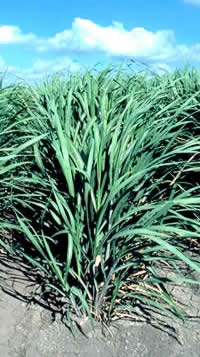
Sugar cane growing in a field in
south Texas. Photograph courtesy of Texas Parks and
Wildlife Department.
|
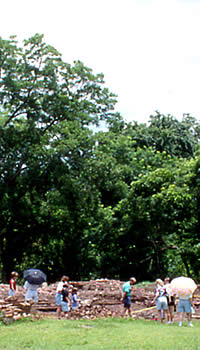
Visitors tour the excavations in
progress at the plantation. Photo by Norman Flaigg.
|
|
Archeological research at sites like Lake Jackson
has provided a wealth of information on the first industry
in Texas, that of refining sugar.
|
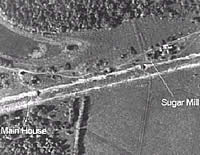
Aerial photo of the Lake Jackson
Plantation taken in 1930, showing locations of main
house and mill. Image courtesy of Lake Jackson Historical
Association.
|
|